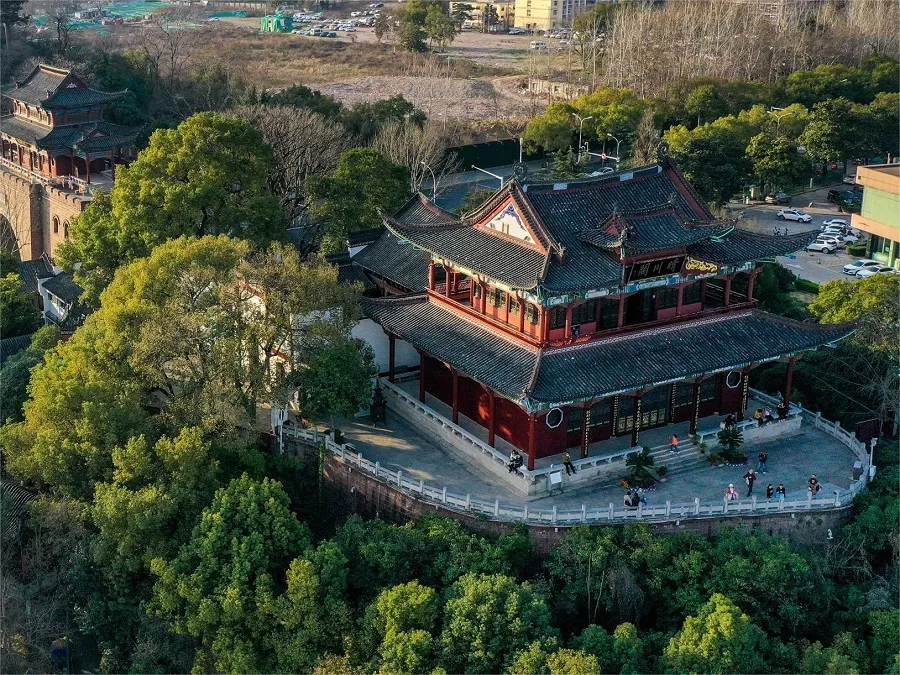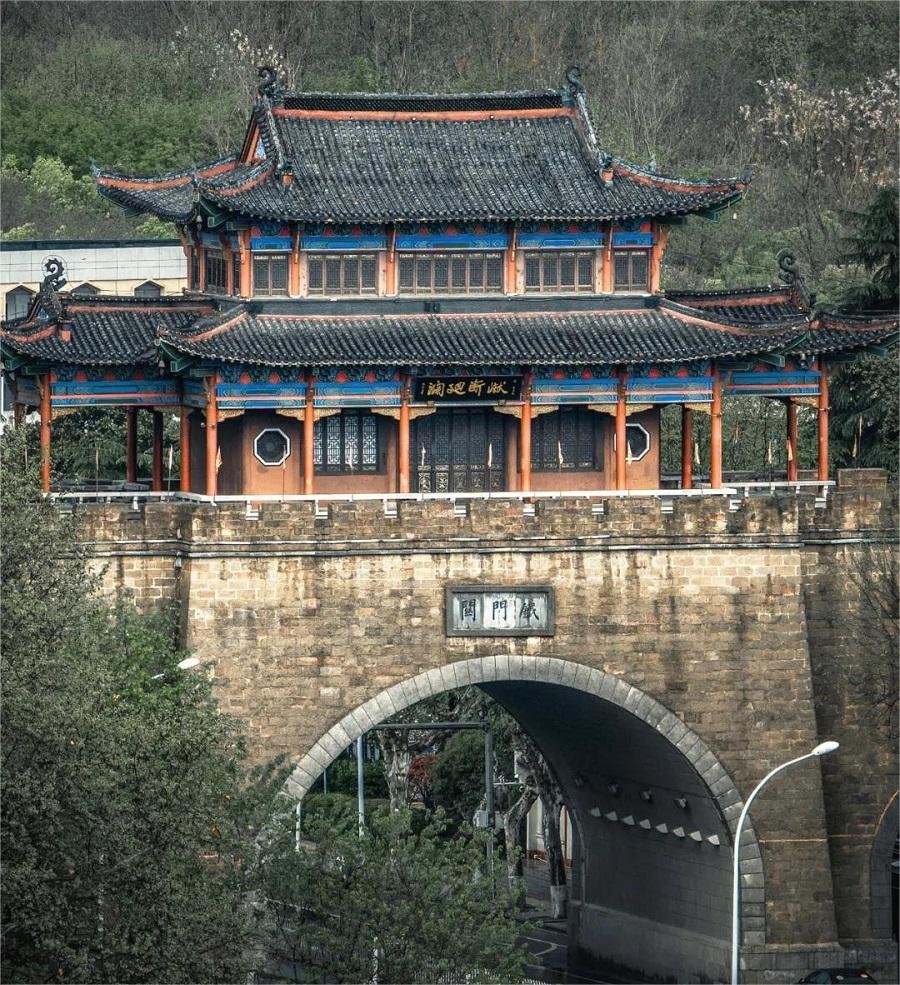Qingchuan Pavilion (晴川阁, Qingchuan Tower), also known as Qingchuan Tower, stands in harmonious contrast with the Yellow Crane Tower across the Yangtze River, creating a picturesque scene. It was originally constructed during the Ming Dynasty’s Jiajing period and was an expansion of the Yuwang Temple, during the tenure of Han Yang’s magistrate, Fan Zhizhen. The name “Qingchuan” is derived from a poem written by the Tang Dynasty poet Cui Hao, which goes: “Clear waters (Qingchuan) winding through the trees of Hanyang, lush grass on the parrot isle.”
Throughout its history, Qingchuan Pavilion has experienced multiple periods of construction, renovation, and restoration, spanning over 400 years from the Jiajing period to the present day. The current structure was reconstructed in 1984 and is renowned as one of the “Three Great Scenic Spots of Wuhan,” alongside the Yellow Crane Tower and the Guqin Terrace. Every year in late March to early April, visitors can enjoy the beautiful cherry blossoms in the vicinity of the elegant Qingchuan Pavilion.
Table of Contents
- Basic Information
- Location and Transportation
- Highlights of the Scenic Area
- Vlog about Qingchuan Pavilion
- Useful Tips Summarized from Reviews
- Attractions near Qingchuan Pavilion
Basic Information
| Estimated Length of Tour | 1 hour |
| Ticket Price | Daytime: Free Nighttime: 68 RMB (Tuesday – Friday) 88 RMB (Saturday and Sunday) Nighttime tour closed on Monday |
| Opening Hours | Daytime: 9.00 – 17.00; Last admission: 16.30 Nighttime: 19.00 – 21.30; Last admission: 21.00 |
| Telephone Number | 0086-027-84710887 |
Location and Transportation
Qingchuan Pavilion is located in the Han Yang District of Wuhan City, Hubei Province, China. Situated on Qingchuan Avenue, it is positioned on the eastern foothills of Turtle Mountain. To the north, it overlooks the Han River, while to the east, it borders the mighty Yangtze River. To get there, you can choose the following ways:
Bus: Take bus 30, 531, 532, 535, 553, 559, 561, 711, or 803 and get off at Qingchuan Avenue Qingchuan Pavilion Stop (晴川大道晴川阁站).
Metro: The closest metro station to Qingchuan Pavilion is Qintai (琴台) on line 6. After getting out of the station, you can walk or take bus 504, 10, or 411 to cover the remaining 2 kilometers.
Highlights of the Scenic Area
Qingchuan Pavilion

Qingchuan Pavilion is a two-story structure with the primary framework constructed from reinforced concrete imitating wood, standing at a height of 17.5 meters. The building features red walls, vermilion pillars, wooden doors and windows, and beautifully painted eaves. A plaque at the front entrance bears the calligraphy of Zhao Puchu, displaying the words “Qingchuan Pavilion.” The entire pavilion covers an area of 386 square meters, with the ground floor measuring 5 bays wide and 4 bays deep, and the upper floor being 3 bays wide and 2 bays deep.
Yuji Imperial Palace

Originally named Dayu Temple, Yuji Imperial Palace is one of the few remaining representative Qing Dynasty wooden structures in the Wuhan region. It was originally established during the Southern Song Dynasty (1131) by Zhang Tiren, the Secretary of Agriculture and subsequently became a site of worship for Dayu, the legendary flood control hero. In the eighth year of the Yuan Dynasty’s Dade era (1304), it underwent a significant reconstruction. During the Tianqi period of the Ming Dynasty (1621-1627), it was transformed from Dayu Temple to “Yuji Imperial Palace.”
The existing structure was rebuilt during the Qing Dynasty’s Tongzhi era (1863). In 1984, it underwent restoration efforts following the principle of “restoring the original state.” The current Yuji Imperial Palace covers an area of 380 square meters and consists of a main hall, front hall, left and right corridors, and courtyards, following a traditional courtyard-style architectural layout.
Iron Gate Pass

Iron Gate Pass‘s history dates back to the Three Kingdoms period, where it served as a vital military fortress in Wuhan during the Wu and Wei dynastic struggles. Over several centuries, from the Three Kingdoms period to the early Tang Dynasty, Iron Gate Pass was the site of many intense battles. In the fourth year of the Tang Dynasty’s Wude era (621), after the construction of a brick wall in Hanyang, Iron Gate Pass’s military significance diminished, and it became an essential passageway for cultural, economic, and trade exchanges.
Towards the end of the Ming Dynasty, Iron Gate Pass was destroyed, leaving behind only the remnants of earth foundations. In the early Qing Dynasty, a temple dedicated to Guan Yu was built on the surviving earth foundations. However, during the early years of the Republic of China, due to conflicts and wars, Iron Gate Pass, along with the temple, was reduced to ruins. In December 1990, reconstruction of the Iron Gate Pass was initiated. The current Iron Gate Pass occupies an area of 800 square meters and reaches a height of 26 meters. The pass’s exterior walls are made of red sandstone, while its internal structure consists of reinforced concrete. The gatehouse features soaring eaves, projecting corners, and exudes a rich ethnic architectural style.
Vlog about Qingchuan Pavilion
Useful Tips Summarized from Reviews
Cherry Blossom Season (Late March to Early April): During late March to early April, visitors can enjoy the breathtaking sight of cherry blossoms near the picturesque Qingchuan Pavilion. The best spot for viewing cherry blossoms is located behind the Qingchuan Holiday Hotel, where a cherry blossom forest awaits.
Weekend Night Puppet Show “Da Yu Qingchuan Love”: On Saturdays and Sundays, there is a special puppet show titled “Da Yu Qingchuan Love” performed near Qingchuan Pavilion. The show starts at 19:30 from the Yu Bei Pavilion and unfolds in four acts at different locations, including the Iron Gate Pass Stairs, Yu Bei Pavilion, Back Garden, and Qingchuan Pavilion, lasting about 40 minutes.
Ferry Ride: To reach Yellow Crane Tower, you can take a ferry from the Qingchuan Pier. After one stop, you’ll arrive at the Yellow Crane Tower Pier.
Scenic Views: Qingchuan Pavilion is situated along the Yangtze River, offering stunning views of the iconic Yellow Crane Tower and the nearby Wuhan Yangtze River Bridge. Visitors can enjoy panoramic views of the river and its surroundings, providing an unforgettable experience.










